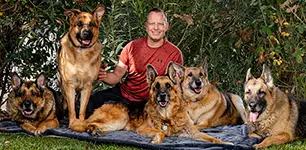
Many pet owners ask me: “How much food to feed my dog?”. While that question seems straightforward, the answer is, unfortunately, not that simple. Much depends on the unique circumstances of your dog. This article explains how to determine the correct amount of food your dog needs daily.
First, dogs are similar to people regarding body weight. Maintaining the proper weight is crucial to good health. However, that is where the similarities end. Your canine companion is a dog, not a person, and dogs have different nutritional needs than people.
Heavy weight dogs usually suffer from arthritic problems. Also increased incidences of metabolic diseases like diabetes and liver problems. Further, a lack of energy and skin problems. They have a shortened life expectancy and are more prone to get and die from cancer.
Underweight dogs, less common than heavy weight dogs, often suffer from a lack of energy. But also poor muscle tone, metabolic and reproductive disorders, and delayed healing.
The benefits of providing proper nutrition in the correct amount are immeasurable. They impact your dog’s health and longevity significantly.
Pet Food Label Recommendations
Look at the feeding recommendations printed on the bags and cans of commercial dog foods. First, you find relatively similar levels of fats, proteins, fiber, etc. Second, you find wide discrepancies (up to 50%) on how much each manufacturer claims the right amount of food is. You can understand why dog food manufacturers want you to feed more—you need to buy more dog food if you run out faster. However, I think most people would agree that feeding your dog should be to their benefit. The balance sheets of the dog food manufacturers are irrelevant in that context.
Given these wide discrepancies, pet food label recommendations are not the best source of information. They are usually based on the weight of a dog. That is not a good way to determine a canine’s feeding requirements. The nutrition a dog needs depends on his caloric energy requirements and not just his body weight.
Understanding Your Dog’s Caloric Energy Needs
People are all reasonably similar in their energy needs. All we have to do is look up our body weight on a chart. Next, make a few adjustments for age and activity level. And finally, get a good read on what our daily calorie intake should be.
However, for dogs, we find huge differences. Canine caloric requirements depend on many factors like breed, size, growth rates in puppies, activity levels, skin and coat thicknesses, and living conditions. Just think of two 90 lb German Shepherds. One lives outdoors and accompanies a hunter on extended hunting trips daily. The other lives in a heated apartment and is walked for one hour a day. Do you think both dogs should eat the same amount of food? Of course, they shouldn’t. But according to the pet food labels, they should.
So how do we do this to ensure we feed our dog the correct amount of food? It’s not hard, and I will walk you through it.
1. Determine the Basic Caloric Needs of YOUR Dog
Nutritionists use a dog’s Resting Energy Requirement (RER) to calculate canine caloric needs. The RER is the basic amount of energy that a dog would use in a day while remaining at rest. The formula to calculate RER for animals between 2 and 45 kg (5 – 99 pounds) is:RER in kcal/day = 30 * (body weight in kilograms) + 70
or
RER in kcal/day = 30 * (body weight in pounds * 0.45359237) + 70
One of my dogs is a 90lb German Shepherd, and we get to its RER like this:
RER in kcal/day = 30 * (90* 0.45359237) + 70 = 1295 kcal/day
The following tables provide the RER based on body weight in pounds and kilograms:
| In Pounds | |
|---|---|
| Weight (lb) |
RER (kcal/day) |
| 5 | 138 |
| 10 | 206 |
| 15 | 274 |
| 20 | 342 |
| 25 | 410 |
| 30 | 478 |
| 35 | 546 |
| 40 | 614 |
| 45 | 682 |
| 50 | 750 |
| 55 | 818 |
| 60 | 886 |
| 65 | 955 |
| 70 | 1023 |
| 75 | 1091 |
| 80 | 1159 |
| 85 | 1227 |
| 90 | 1295 |
| 95 | 1363 |
| 99 | 1417 |
| In KG | |
|---|---|
| Weight (kg) |
RER (kcal/day) |
| 2 | 130 |
| 5 | 220 |
| 10 | 370 |
| 15 | 520 |
| 20 | 670 |
| 25 | 820 |
| 30 | 970 |
| 35 | 1120 |
| 40 | 1270 |
| 45 | 1420 |
2. Adjusting the Basic Caloric Needs Based on YOUR Dog’s Activity Level
Now we know how many calories our furry friend would need if it wouldn’t move a muscle all day. Next, we need to calculate what it actually needs as your dog is probably not sleeping 24/7. The following table will help with this adjustment to figure out how much food to feed my dog.
| Activity | Daily Energy Req. (kcal/day) |
|---|---|
| Weight loss | 1.0 x RER |
| Neutered adult, normal activity | 1.6 x RER |
| Intact adult, normal activity | 1.8 x RER |
| Light work | 2.0 x RER |
| Moderate work | 3.0 x RER |
| Heavy work | 4-8 x RER |
| Pregnant dog (first 42 days) | 1.8 x RER |
| Pregnant dog (last 21 days) | 3.0 x RER |
| Lactating female | 4-8 x RER |
| Puppy – weaning to 4 months | 3.0 x RER |
| Puppy – 4 months to adult size | 2.0 x RER |
My German Shepherd is a 6-year-old, neutered male who enjoys 1 hour of rollerblading per day plus 1 hour of walking. I am classifying him as a “Neutered adult, normal activity.” That means I need to adjust the RER by 1.6. Hence my dog needs: 1295 kcal/day * 1.6 = 2072 kcal/day.
3. Additional RER Adjustments
While we have a pretty good idea of the daily calorie requirements from steps 1 and 2, there are additional considerations. They can change those numbers. Especially characteristics like breed differences, air temperature, and coat insulation can alter an individual dog’s energy requirement as much or more than any of the activities listed above.
Because of this, it is unfortunately impossible to provide a one size fits all recommendation for every dog. Every dog’s nutritional needs are different.
However, the RER we calculated is a good starting point, so your dog is not going hungry. In determining what your dog ultimately gets in terms of daily calories, you must factor in any treats or table food you might give. These extras must be included in determining how much food to feed my dog.
Getting Started
Start feeding your dog the calculated amount of calories and monitor its weight. Weigh it bi-weekly to check if it is losing or gaining weight or remains stable. If your dog is at a good, healthy, stable weight, you want to avoid weight fluctuations. In that case and the amount of food is okay. Should it gain weight, feed some less. Should it lose weight, feed some more. This doesn’t have to be complicated. For example, if your dog always leaves food in its bowl, feed less and see how it responds.
Are concerned about making any mistakes in feeding your dog? Do you have specific weight loss/gain goals? Does your dog have health problems? Have your veterinarian fully diagnose and assess your dog’s health. But, keep in mind that veterinarians don’t have much nutritional knowledge. It’s not their fault. Veterinary school is limited in that regard, just like with doctors for people. Generally, the food they sell at veterinary offices is some of the worst. Don’t take my word for it. Read the labels of Science Diet and Royal Canin’ and decide if what’s in those bags sounds like healthy dog food.
If you need help, I recommend you take your medical records and consult with a certified canine nutritionist. I also have heard Just Food For Dogs is developing custom diets for dogs upon request. Their frozen veterinary food lines are now even available at Petco.
4. Basic Feeding Tips
- Most dogs should be fed once a day around the same time. Feeding at the same time will keep your dog on a predictable bathroom schedule. With puppies, you should feed them 2-3 times a day initially. For adults feeding once a day is healthier.
- Feed your dog the same type and brand of food every day. Unlike humans, a dog’s digestive system does not handle changes in food well. It can cause an upset stomach and diarrhea.
- When switching to a new food, gradually transition your dog by mixing portions of both foods until you slowly phase the old food out. Your dog may experience diarrhea if his food is suddenly changed. I recommend changing the food mix in 1/4 increments every two days. As a result, the transition takes about one week.
- If you are adding water to your dry food, you should mix four parts of dry food with one part of water.
- Keep fresh drinking water available at all times. Change the water at least once a day, more often for dogs that drool.
- Keep food and water bowls clean; wash them daily.
- Don’t overfeed your dog. Monitor your dog’s weight and activity level, and make feeding adjustments as necessary.
This article solely focuses on how much food to feed your dog. Not what kind of food to feed. High-quality, organic, natural foods are preferable over cheap by-product-laced junk. In my article My Vet Said … you can read more about the challenges related to commercially available dog food. Reading labels can be enlightening with dog products, as that market is far less regulated than that for human food.
References and Further Reading
- Small Animal Clinical Nutrition 4th Edition by Hand, Thatcher, Remillard, and Roudebush; Walsworth Publishing Company. Marceline, MO; 2000.
- Small Animal Clinical Nutrition 5th Edition by by Hand, Thatcher, Remillard, Roudebush, and Novotny; Mark Morris Institute, 2010
- PetEducation: How Much Should I Feed My Dog?
Play the Audio





